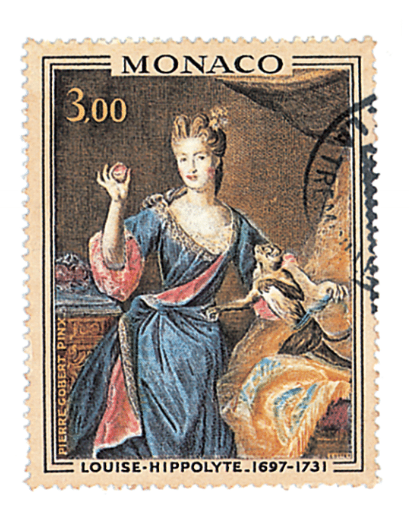Stamp Collecting Is Art Collecting
In Postmark Paris—originally published in 2005, and issued in a beautiful new edition in 2020—Leslie Jonath chronicles her childhood adventures in the City of Light, through a series of lyrical vignettes and images of the gorgeous stamps she collected there.
The first stamp I ever bought—at the age of eight—showed a woman in a long green dress, carrying an even longer black stick. Behind her, the background is orange and white. I loved that stamp, because I thought it showed Annie Oakley holding a rifle, with fire and smoke rising behind her. Later on, I learned that the picture wasn’t actually of Annie Oakley at all. In fact, it was a miniature recreation of Woman Playing Lute, a painting by Jean-Antoine Watteau.
I didn’t know it that day, but I had just started something big—a lifelong project. I had become a stamp collector, and I had just acquired my first mini-masterpiece.
I was just a kid then, living in Paris with my family for a year. Throughout our time there, whenever we had the chance, my dad and I would head down to the open-air stamp market off the Champs-Elysées. We would stroll among the tables, covered with timbres, and I would search for the next piece to add to my collection. I went to that stamp market at every opportunity. Then, I would take my treasures home and mount them on the crackly, transparent pages of my stamp album.
Later, during our first visit to our neighborhood stamp shop, my father and I each chose one French stamp. I selected a stamp featuring a young blonde dressed in a blue jacket and hat, seated in profile and gazing off into the distance. The image reminded me of photos I had seen of my mother when she was a little girl in Brooklyn. When I chose that stamp, I had no idea that I had picked up a tiny version of Pierre-Auguste Renoir’s Portrait of Margot. That painting—along with Les Baigneuses, Bal du Moulin de la Galette, and Renoir’s portrait of his friend Claude Monet—now hangs in the Musée d’Orsay. Renoir is considered one of the fathers of Impressionism, and now, I had a stamp-sized version of one of his works.
As I browsed through the books of beautiful timbres over the ensuing months, stamps of all kinds would catch my eye. I would pick stamps for their colors, patterns, and scenes, and I gravitated especially to stamps featuring animals. One day, I bought a big, richly-hued stamp from Monaco which showed a young woman holding a piece of fruit, a curious monkey by her side. (In fact, it was a miniature version of Mademoiselle de Conti by Pierre Gobert, one of Louis XIV’s court portraitists.) Another time, I selected an ominous-looking stamp centered on a big white horse rearing up dramatically. (I had no idea that the stamp depicted a battle, nor that the painting it was based on, Théodore Géricault’s Officier de Chasseurs à Cheval de la Garde Impériale Chargeant, was hanging in the Louvre.) But of all my animal stamps, my most prized one depicted a smiling unicorn seated next to a woman, gazing into a mirror and studying its own reflection. (This stamp, in fact, had the most ancient roots of all: a tapestry dating back to the 16th century.)
Other times, I chose stamps that reminded me of people and things in my own life. For instance, one day, I dropped into the stamp shop after school, my mind aflutter with thoughts of a boy in my class, Sacha. That day, I chose a mesmerizing, dream-like stamp with a bride and groom floating in the foreground, a woman, a goat, and the Eiffel Tower hovering in the air behind them. Months later, I went to the ballet with my family. Before the lights dimmed and the show began, I stared up at the painted ceiling—full of dancing animals and blue violinists. Suddenly, my eyes found a surreal image: a bride and groom, tilted sideways, as though they were floating above the chandelier. Then, I realized it: that bride and groom on the ceiling were the very same bride and groom that were on my beautiful 85-cent stamp. When I got home that night, my parents and I looked at the stamp, and learned that it was a tiny reproduction of Marc Chagall’s Les Fiances de la Tour Eiffel. At that moment, I made the connection. I had collected a whole book of mini-masterpieces.
To see all of these mini-masterpieces and hear the stories behind them, check out Postmark Paris, available on Indiebound and wherever books are sold.







